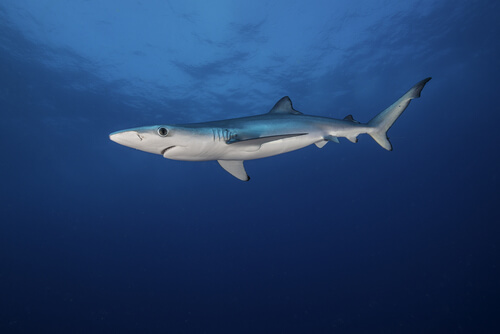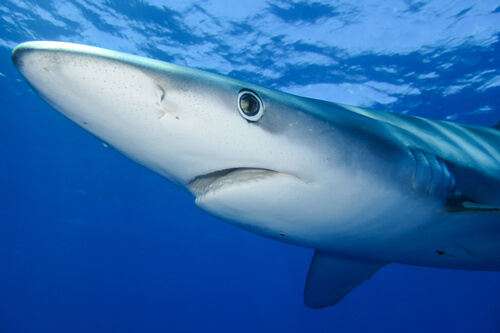
| Kingdom | Animalia |
| Phylum | Chordata |
| Class | Chondrichthyes |
| Order | Carcharhiniformes |
| Family | Carcharhinidae |
| Genus | Prionace |
| Species | P. glauca |
| Niche | Pelagic Predator |
| Length | Up to 10 ft (3.1 m) |
| Weight | 60-400 lbs (27-182 kg) |
| Lifespan | 20 years |
| Social Structure | Solitary |
| Conservation Status | Near Threatened |
| Preferred Habitat | Tropical and Temperate Oceans |
| Average Litter Size | 25-50 |
| Main Prey Species | Schooling fish, squid |
| Predators | Larger sharks, orca |
The Basics
The blue shark is a medium-sized pelagic shark. It is long and sleek with an indigo-blue colored dorsal side and is known for its long migrations and ability to swim rapidly.
Blue sharks have a slender body and can grow to up to 10 ft long and weigh up to 400 pounds in the largest specimens. They have large, pointed pectoral fins and two dorsal fins. Their tail is relatively large, with the upper lobe larger than the lower lobe. This tail provides excellent swimming power as it sways side-to-side while they roam the oceans. Their snout is pointed and they have large, black eyes set over their small mouths. The blue shark’s overall tapered body – reminiscent of a torpedo – makes them very graceful swimmers. Blue sharks are counter-shaded, with their dorsal side an indigo-blue to dark grey color while their underside is off-white.

Distribution and Range
Blue sharks can be found throughout the temperate and tropical waters of the world’s oceans. In fact, they can be observed along the coasts of every continent except for Antarctica. They are an epipelagic species, typically inhabiting offshore waters and depths of up to 1,100 feet. However, they will occasionally approach the coast, particularly in temperate waters, where they can be observed by divers.
Prey and Predators
One of the blue shark’s most common prey items is squid. They will also hunt other similar species such as octopuses and cuttlefish. Also, they prey on various species of fish and shellfish including lobsters and crabs. Less frequently, blue sharks will prey on sea birds, snatching them from the surface while they rest.
Blue sharks face the threat of predation from larger shark species such as the tiger shark and great white shark. Orcas will also hunt various shark species including the blue shark. Young sharks are of course more vulnerable to predators than large adults. However, by far the greatest threat to blue sharks are humans, with up to 20 million of this species alone killed each year by fisheries.
Reproduction and Conservation
Blue sharks are a viviparous species, nourishing their young in the uterus and giving birth to between 25 and 50 live pups. In some cases, litters of as many as 135 pups have been observed. These new-born pups measure 16 to 20 inches in length and are independent from the moment they are born. The blue shark is listed on the IUCN Red List of Threatened Species as near threatened.
Fun Facts about the Blue Shark!
A Shark’s Shark
The blue shark has an appearance that can be described as the quintessential shark. Despite their torpedo-like shape, they are actually known to be generally lethargic, moving slowly in their travels to conserve energy. However, when faced with the threat of a predator or the opportunity to find prey, their morphology – their slender body and large tail in particular – allows them to move very quickly.

The Great Traveler
The pelagic blue shark is found in most temperate and tropical waters and is known to migrate long distances. For example, one confirmed migration pattern includes traveling from the waters of New England, USA all the way to South America. Other studies have documented sharks traveling from the west coast of Europe to north-west Africa and even across the Atlantic where it was caught 3,187 km from where it was tagged.

An Unlikely Threat
In addition to the somewhat obvious threat of predation that blue sharks may face from larger shark species and other predators such as orca, they may be on the menu of some less expected species as well. For example, in Norway, northern elephant seals have been observed feeding on blue sharks. Clearly, the ocean can be a threatening place even for a blue shark.
A Smaller Problem
Not all threats are large. One of the greatest problems for blue sharks is the threat from parasites rather than large, predatory sharks or whales. One such parasite, a tetrahylidean tapeworm known as Pelichnibothrium speciosum uses the blue shark as its definitive host, spending its life there after the shark eats an infected intermediate host such as a fish. This organism can create health issues for its host as it deprives it of the nutrients it may otherwise obtain from its food and causes other digestive problems.
Truly Thick-Skinned
The reproductive behavior of the blue shark consists of some interesting details and may even impact the species’ non-reproductive morphology. During courtship, males tend to bite the females, often leaving scars. This is so common that adult blue sharks can be sexed simply by determining the presence or absence of bite marks around their head. To withstand this behavior by males, females have adapted to develop a thick skin to protect themselves. In fact, the skin of females is approximately three times as thick as that of males of the species!
